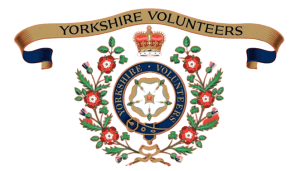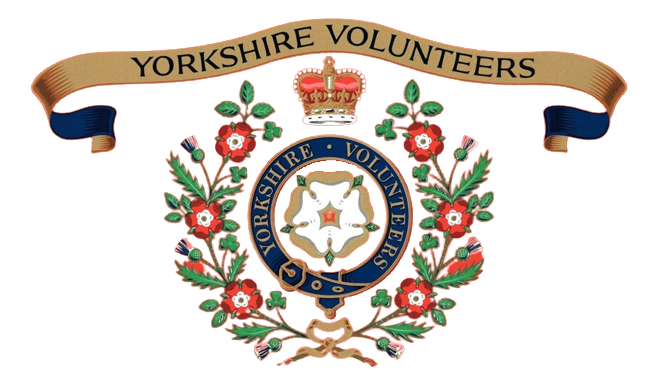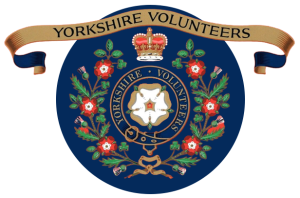American Civil War
The 90th Regiment of Foot (Yorkshire Volunteers) was a line Infantry Regiment of the British Army during the American Revolutionary War.

The 90th Regiment of Foot (Yorkshire Volunteers) was a line Infantry Regiment of the British Army during the American Revolutionary War.
The Regiment was raised in Yorkshire in 1779 and was posted to the Leeward Islands under the command of General Loftus Anthony Tottenham, arriving in January 1780. It returned to England in 1783 and was disbanded the following year.
The Yorkshire Volunteers, a Territorial Army Infantry Regiment of the Line, was formed on 1st April 1967 and, being a Regiment formed by the amalgamation of Territorial Army major units, is successor to:
The Defence Review of 1966 directed a sweeping cut-back in the size of the Territorial Army. As one result, the Yorkshire Volunteers was formed by the amalgamation of elements of the Territorial Army battalions of Yorkshire’s infantry regiments. The Headquarters of the new Regiment was at York and four rifle companies were based at York, Middlesbrough, Halifax and Sheffield. In 1969 a fifth company was formed in Leeds from elements of the Leeds Rifles and the five parent Territorial Army major units were reduced from battalion to cadre strength and placed under the administration of the Yorkshire Volunteers.
In 1971, the 2nd Battalion and 3rd Battalion Yorkshire Volunteers were raised by the five infantry cadres together with the cadres of the three remaining Royal Artillery Territorial Army Regiments in the County of York. The two Battalion Headquarters were at York and Huddersfield respectively. The new companies were, in the main, raised upon the detachment locations previously used by the 1st Battalion Yorkshire Volunteers.
A further reorganisation, completed on 1st January 1988, resulted in the formation of a 4th Battalion, but on the 4th April 1992 the 3rd and 4th Battalions amalgamated to become the 3rd/4th Battalion Yorkshire Volunteers with its Headquarters at Sheffield.
The conclusion of the Options for Change review of the Territorial Army saw the introduction of a policy of closer linkage between Territorial Army Battalions and their Regular counterparts. As a result, the Ministry of Defence directed that the Yorkshire Volunteers was to be disbanded and that its constituent Battalions would, in future, separately form part of the Yorkshire Infantry Regiments of the Line.
All three Battalions resulting from this reorganisation bore the secondary title Yorkshire Volunteers. The Band, alone, remained; continuing to serve its Territorial Army Battalions and administered by the 3rd Battalion The Prince of Wales’s Own Regiment of Yorkshire (Yorkshire Volunteers), but still designated The Band of the Yorkshire Volunteers.
The affiliation between Yorkshire Volunteers and HMS Sheffield was maintained by 3rd Battalion The Duke of Wellington’s Regiment (West Riding) (Yorkshire Volunteers).
On the 25th April 1993, slightly less than a year after the 25th Anniversary Celebrations, a Regimental Parade and Service of Rededication was held in Catterick Garrison to mark the disbandment of the Yorkshire Volunteers, in the presence of Her Royal Highness The Duchess of Kent GCVO, Honorary Colonel Yorkshire Volunteers.
The TA battalions of the three Yorkshire Infantry Regiments were each reduced, forming part of two multi-badged battalions.
The two remaining Green Howards companies, one in Scarborough, with a detachment in Northallerton, the other in Middlesbrough with a detachment at Coulby Newham were “removed” from Yorkshire and placed into the new Tyne Tees Regiment. The two 3PWO companies, York and Hull, joined with 3DWR companies at Barnsley and Huddersfield, and a re-formed Light Infantry company at Pontefract, in the newly created The East and West Riding Regiment. The Band, which had survived the 1993 “Options for Change” was finally axed with effect from 1st April 1999.
However, following a trend established almost 120 years earlier, the band did not disappear.
Although not following a strict lineage, former Yorkshire Volunteers had remained in a Drill Hall in Rotherham and become 146 Recovery Company REME, and soldiers of 4/5 Green Howards rebadged as 104 (Pioneer) Squadron, Royal Logistics Corps, in Coulby Newham.
It is said that “what goes round, comes round”. It is interesting to note that in 1969 when the Leeds Rifles joined the Regiment, they brought with them an Assault Pioneer Platoon, which was “dropped” only a few years later. In 1999, former Yorkshire Volunteers again adopted the role of Pioneers. Some would say they had always been pioneers!
The Yorkshire Volunteers, in 1999, is succeeded by the following:
The East and West Riding Regiment
Tyne Tees Regiment
The Yorkshire Volunteers Band can trace its history back to 1860 when it was formed as as the Band of the 7th Yorkshire West Riding Rifle Volunteer Corps (Leeds Rifles), which had been formed in 1859.
Today the band forms an integral part of the Yorkshire Volunteers Regimental Association, performing throughout the UK and Europe in both concert and marching band formations.
The band maintains the long traditions of the Yorkshire Volunteers adding a touch of pomp and circumstance to any event from traditional summer bandstand concerts to country shows with everything in between.
The uniform worn by the Band was initially green, but it later adopted the 1891 pattern of Rifle Brigade dress.
The uniforms in use today are the traditional scarlet tunics of British Army infantry bands.
The Dixieland Jazz band uniform is a traditional Dixieland style incorporating the red and white Regimental colours of the Yorkshire Volunteers.
The original Regimental March was “The Huntsman’s Chorus”.
During the 1870’s this was changed to “I’m Ninety-Five”.
In 1887, when the Leeds Rifles became the 3rd Volunteer Battalion the Prince of Wales’s Own (West Yorkshire Regiment) (Leeds Rifles), they adopted “Ca ira” (Click to Listen) as the Regimental March. This Former French Revolutionary marching air was “stolen” by the 14th of Foot at the Battle of Famars in 1793. Drummers of the 14th were ordered to strike up the tune that the French were playing, causing confusion and dismay among the enemy.
In 1967 the Yorkshire Volunteers Regiment was formed from the Territorial Battalions of the Yorkshire Infantry Regiments:
the Prince of Wales’s Own Regiment of Yorkshire,
the Green Howards,
the Duke of Wellington’s Regiment and the Hallamshire Battalion,
the York and Lancaster Regiment
The Leeds Rifles Band became part of this new Regiment, but was designated “The Yorkshire Brigade Band TAVR” now wearing a blue uniform.
In 1969 the name changed to the Regimental Band Yorkshire Volunteers (Leeds Rifles).
Subsequently, the band became known as The Yorkshire Volunteers Band and adopted the traditional scarlet tunic of British Infantry bands and has “Ilkla Moor” as it’s regimental march.
After the Strategic Defence Review of 1998 the band were “disbanded”, but decided to soldier on as part of the Yorkshire Volunteers Regimental Association with kind permission of HRH The Duchess of Kent, and retained the right to wear the Queen’s uniform in public ensuring over 150 years of “True Yorkshire Grit”.
REME, 146 Recovery Company
Royal Logistics Corps, 104 Pioneer Squadron
In April 2006, the two Green Howards companies of Tyne Tees Regiment will merge with East & West Riding Regiment, prior to becoming the 4th Battalion, The Yorkshire Regiment, on the 6th June. This will restore things to much as they were thirty five years ago!
The Yorkshire Volunteers (former) Regimental Chapel is within York Minster, dedicated to Saint Cuthbert, a great 7th century saint of the North, consecrated on 24th April 1982 in the presence of Her Royal Highness The Duchess of Kent. Funding for the Chapel was provided by the Yorkshire Volunteers Regimental Trust and friends of the Regiment.
The overall planning of the Chapel was by Mr Charles Brown, Surveyor of the Fabric, York Minster. The Prayer Desks and Altar were fashioned by Mr W. M. Wilson of Baldersby in elm, principally from the Hotham Estate. Mr J. E. Hill of Hunmanby made the Crucifix and Candlesticks. The Canopy, Base and Altar Rails were made by York Minster’s craftsmen.
In 2011, the Trustees of the Yorkshire Volunteers Regimental Trust handed back St. Cuthbert’s Chapel to York Minster, the trust was then wound up.
The Yorkshire Volunteers Regimental Association continues the tradition of an annual service in the Regimental Chapel, usually late October. The dates for future services are published in the calendar of events.
Painting of St. Cuthbert’s Chapel, York Minster
Copyright © 1998 , 1999, 2005, 2018

